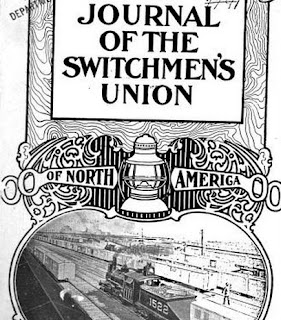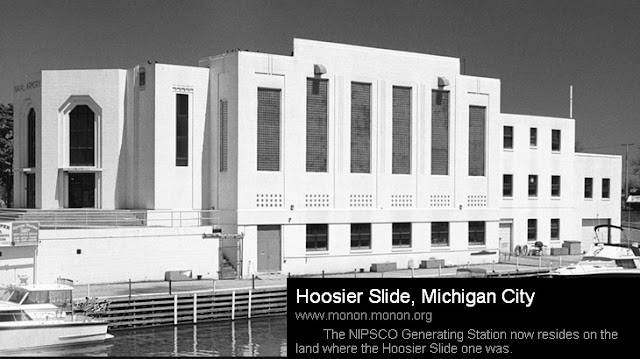
"It's all in the sand, baby!"
Once the largest sand dune on Lake Michigan, the Hoosier Slide was a tree-covered tourist attraction, used for picnics and even weddings.
Visitors enjoyed sliding down the loose sands.
Then stripped of its timber by the 1870's, it became a sand-blowing nuisance.
Commercial sand mining began about 1890, when the Monon Railroad built a switching track along the south side of the dune.
Also in 1890, natural gas was discovered in central Indiana, and glass factories started in the Muncie area. Large users of Hoosier Slide sand were the Ball Brothers in Muncie, Pittsburg Plate Glass in Kokomo, and the nearby Hemingway Glass Co.
The sand was found to be good for glass making, and thus the once loved Hoosier Slide was sold off, wheelbarrow by wheelbarrow. The great sand dune was reduced to nothing.
W. Manny Dieckilman, the son of a man who worked the Hoosier slide shares this info about the 3 men pictured at lower left of this postcard:
"The 3 men pictured on the train tracks with Hoosier Slide in the background are: left, Dan Hutton, Train Master of the Monon Railroad” center, on tracks is Henry Dieckilman, Foreman (working there for 25 plus years), on right, William Manny, owner of Hoosier Slide."
"Although I hold no memory of my father, who died when I was three in 1921, I am forever conscious of the footprints remaining from his labors in the late 1890's and early 1900's. For twenty-five years, six days a week, he pushed an iron-wheeled wheelbarrow, moving sand from Hoosier Slide onto gondola carts headed for the manufacturing of canning jars.." --W. Manny Dieckilman
Henry Dieckelman is listed in the Michigan City, City Directory, 1913, as the Foreman of the Hoosier Slide Sand Co. [Source]
According to "Naturalization records : abstractions from declaration of intentions, Superior Court, Michigan City, La Porte County, Indiana", Henry came from Germany in 1880. (Note the different spelling of his last name from his son, W. Manny Dieckilman.) [Source]
Read more of W. Manny Dieckilman's memories on emichigancity.com.
William B. Manny, proprietor of the Hoosier Slide Sand Company, is profiled in a1904 book [here].
Dan Hutton was listed in the Railroad Switchmens Union in 1901 [Source] as Michigan City's Monon Yardmaster [Source].
Once Indiana's most famous landmark, Hoosier Slide was a huge sand dune bordering the west side of Trail Creek where it entered Lake Michigan. At one time it was nearly 200 feet tall, mantled with trees. Cow paths marked its slopes and people picnicked upon its crest. Climbing Hoosier Slide was very popular in the late 1800's with the excursionist crowds who arrived in town by boat and train from Chicago and other cities. The summit, where weddings were sometimes held, afforded an excellent view of the vast lumberyards which then covered the Washington Park area.
With the development of Michigan City, the timber was cut for building construction and the sand began to blow, sometimes blanketing the main business district of the town on Front St., which nestled near its base.
When it was discovered that the clean sands of Hoosier Slide were useful for glassmaking, the huge dune began to be mined away. Dock workers loaded the sand into railroad cars with shovel and wheelbarrow to be shipped to glassmakers [and other places].
Over a period of 30 years, from about 1890 to 1920, 13 1/2 million tons of sand were shipped from Hoosier Slide until the great dune was leveled. By the 1920's, nothing remained of the giant dune.
In 1929, NIPSCO (Northern Indiana Public Service Company) built a power plant on the Hoosier Slide site.
_____________________
Once the Hoosier Slide sand was all used up, Ball had to get another source, and the glass formula was forever changed. No more pretty Ball Blue glass.
Aqua glass is a "natural" result of the iron impurities found in most sands. It is very rare (maybe unknown) that sand does not contain some traces of iron. Sand deposits with very low iron content were (and probably still are) highly valued commodities. Although good quality sand was plentiful in the Eastern United States, some was still being imported from Belgium for Western American glass factories as late as the 1940s. Aqua glass is the result of sand which is relatively low in the amount of iron which was not off-set by de-colorizing agents. High levels of iron produce darker greens, black glass, and even amber. Natural aqua glass was often called "green glass," "bottle glass," or "bottle glass green" by glass makers.






































No comments:
Post a Comment
Please leave us a comment - we love to hear what you have to say!